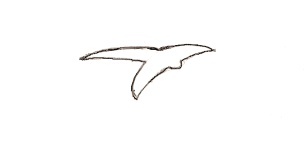This morning I heard the sound of a lonesome dove.
When seeking a mate male mourning doves call like the ones in this video. Those who’ve found true love don’t need to sing because the cooing is a solicitation call, not a territorial defense.
Unmated males perch-coo from the heights as loudly as they can, “Ladies, I’m available.” It’s amazingly loud considering they don’t even open their mouths. A few have already begun calling in my neighborhood but the peak time will be late April through June.
Males also use flap-glide flight to attract female attention. Taking off with exaggerated wing-claps, they fly up above the trees and rooftops, then spiral down with stiff wings held slightly below their bodies. From a distance their silhouettes resemble kestrels or sharp-shinned hawks. They’ve fooled me more than once. Here’s my attempt at what they look like, gliding from left to right:

Today sunrise is at 6:49am so a lot of us are awake before the perch-cooing begins, but lonesome doves can be annoying in June when they start calling at 5:00am.
Quiz! Test your “birding by ear” skills with this video. In addition to the mourning dove there are at least seven other species singing in the background. Who are they?
(video by Carl Gerhardt, musicofnature.org via YouTube. Silhouette drawing by Kate St. John)
Kate,
7? Damn, I just don’t hear as well as I used to. I think i heard tufted titmouse, house sparrow, red-eyed vireo, ovenbird, and maybe a blackpoll warbler?
Just curious, what ere the seven?
Art
Art, Here’s what I heard — might be wrong:
Northern cardinal very early in the recording
Tufted titmouse
Red-eyed vireo
Yellow-throated vireo (the quality of the later vireo’s song was burry)
Nashville warbler (it was two-part ?was it blackpoll?)
Eastern wood-pewee
Carolina wren
But my ears are REALLY rusty after this long winter.
Loved this film and the sounds of the mourning dove-I must have had a whole community in my old neighborhood in the town I live in.I saw them in my back yard and heard them daily, most in the early am+evening.What’s funny is,I moved about 2miles from my old house and never see them or hear them!!What do they like to nest in?My old next door neighbor had beautiful giant fir or evergreen trees.
Also,would you please feature a pic and info on blue cranes?I’ve always thought they were such gorgeous creatures.And starting last spring,there is one that comes daily to a pond on the farm where I work!I can’t believe how lucky I am to see one in person-even prettier than pictures.And would it be a male or female? How can you tell? Why would he or she come for the 1st time LAST year/where do they winter? The pond is located in Jefferson County and there are fish in it!Do they nest in trees? Please answer when you get a chance,THANKS! Marie
Marie, mourning doves like to nest in evergreens so that may explain the difference between your old neighborhood & your new one. The blue crane you’re seeing is actually a great blue heron. They love to eat fish. Here are a few articles I wrote about them.
Great Blue heron rookeries & nests:
http://www.birdsoutsidemywindow.org/2010/03/23/heron-rookery/
http://www.birdsoutsidemywindow.org/2010/03/24/heron-sunrise/
August is when the juvenile herons get ready to fly:
http://www.birdsoutsidemywindow.org/2009/08/05/time-to-go/
Thank you very much for answering-read all articles and sure explains a lot.Just It really helps for one like me who loves to birdwatch,but only have limited time(often sit in my car in my driveway)but are fascinated just the same!Please keep up the wonderful work…
We used to see a lot more mourning doves in this area of California (Central Valley), but now they seem to have been run out by the ring-necked doves (possibly called Asian doves). Do you know of any studies to show if this is the case? I miss the familiar call of the mournings, as it is a sound I grew up with in Florida and Pennsylvania. Sad to see so few of them around now. We certainly have plenty of the others though!
Hello! Have a very general question:Do you know what kind of bird makes what I call the “YooHoo” call?I live about 100 miles east of Pittsburgh and it is frequently heard here, only in the spring and summer. Also,can you please explain why I often see geese flying singly or in pairs + honking?I never used to see less than SIX from the time I can remember and I grew up in this area.So it seems perhaps environmental changes have occurred? Or,do they sometimes get lost from their flock?Thanks,Marie
Two very good questions, Marie.
YooHoo call: There are several birds this could be. One guess: Black-capped chickadees ‘sing’ Yoo hoo in spring/summer. This clip has the YooHoo call starting at 1:30 into the recording. http://macaulaylibrary.org/audio/98802
Another possibility is the blue jay’s kweedle call which is sometimes only 2 syllables. The birds in this recording are tweedle-ing more than yohoo-ing. http://macaulaylibrary.org/audio/138502 (Also see here: I Can Sound Pretty
Two Canada geese: Canada geese only migrate if their parents teach them to. Years ago the PA Game Commission introduced Canada geese into Pennsylvania (for hunting) and that population never learned to migrate. By now there are so many non-migratory Canada geese in Pennsylvania that in the spring you see individual pairs flying around from roosting to feeding sites. Eventually the pairs will choose a place to lay eggs and raise a family & at the end of the summer you’ll see larger groups again.